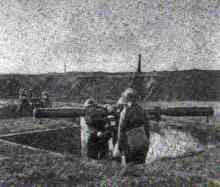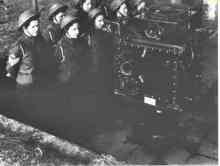
History - Gunners
(A.T.S. Remembered)
 |
History - Gunners(A.T.S. Remembered)
|
As a consequence of bringing women under military law in April 1941 it became possible to create Mixed Anti Aircraft Batteries of the Royal Artillery. General Sir Frederick Pyle who was the Commander in Chief of Air Defence G.B.was very active in the creation of the Mixed Anti Aircraft Batteries. The Government was very keen to emphasise that these women would not 'pull the trigger' as it was felt it would not be acceptable for 'life givers to be life takers'.
 |
A.T.S.
were soon deployed to the Royal Artillery (R.A.) to make up Mixed Batteries.
They took over some of the tasks that men were already doing to find enemy
aircraft and control the direction the gun(s) would fire in. First of
all they were sent to training camps to learn the instruments they were
to use. They were then selected to go to specific R.A. Batteries - once
allocated the whole gun laying team was sent to practice camp to learn
how to work together, before being deployed to their Battery position.
Some women went to permanent camps and some became mobile so that they
could replace Batteries who were moving for various reasons at very short
notice. When the V1s were being sent across the channel many of the Batteries
moved to what was known as 'doodlebug alley'. The Batteries were moved
to temporary sites to cover a dense area on the south east coast of the
country where most of the V1 rockets were coming across. Many of the Batteries
were accommodated in tents with no permanent water or washing facilities.
Added to this, they were firing almost constantly for hours on end, trying
to knock the very fast rockets out of the sky. |
A.T.S. were trained to use several pieces of equipment. The 'spotter' telescope or T.I., the height and range finder, predictors, sound detectors and radar.
|
 |
|
 |
|
 |
Various different types of sound detector were used and these were basically large cones of different shapes and sizes attached to a moveable chassis. The sounds the cones picked up were electronically enhanced and this enabled the operators to alert the rest of the team to the possible location of enemy aircraft.
Once radar was on the scene, this was used to find the height and range of aircraft, but the information was still sent to the predictor to control the aim of the gun. More details about radar will be added to this site in the near future.
Another instrument that was used by A.T.S was the kinetheodolite. This was only used at practice camps but this was based on the theories of cinema and theodolites combined. The operators would film mixed battery detachments firing at drones on the practice camps. The films were taken back in the evening to the camp headquarters and the operators would use the measurements taken, together with the film to work out how close to target each team was firing. This enabled teams to adjust their procedures in order to become more accurate. The work of the kinetheodolite operators was very mathematical and only those who were very good in this subject were able to cope with the calculations that had to be made each day. One problem that was experienced during hostilities was the problem of maintenance of the instruments. They were German made and it was obviously very difficult to go and ask for spares!
Z Rockets were also fired by R.A. Batteries including the mixed batteries, and again the instruments described above were used to control and aim the rockets as they were fired.
The predictor could be classed as a mechanical computer which, with the other instruments mentioned was operated by women in order to control the guns of the heavy ack ack batteries. In this sense there is a very fine line between stating these ladies did not fire the guns and the work they actually did. To all sense and purpose, the operators of today are considered to 'press the button' even though they are doing this remotely by computer control. It was rather deceitful of the Government of World War 2 to state that women 'did not pull the trigger' when they knew jolly well that what they did was as close as you could possibly get to actually firing the guns.
BuzyBee
Web Design  |